Basic hygiene in dairy farming is important to ensure that cows are healthy and happy in their environment.
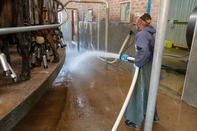
A milk storage room should be clean at all times and must be sited in a clean area, away from obvious sources of contamination and separate from any wash-up areas. Keeping the milking area, the cow's housing, udders and surroundings clean can help ensure hygienic milk and prevent the spread of diseases.
Your cow's housing should always be clean, with clean bedding (straw or sawdust), water and feed troughs, and feed. It is also important that your cow's housing is well ventilated. It is important to prevent insects, rodents and birds in the milking area and not allow pets or poultry into the milk storage, milking or animal housing areas.
The milking parlour should have cement floors, which should be washed or hosed down before and during milking. Be aware that warm, wet conditions breed bacteria. The milker must wash their hands before and after milking each cow and wear clean protective clothing such as face masks, gloves, water boots and an overall.
After washing, dip hands in disinfectant. When milking by hand, wash hands before milking and dip hands in teat dip before milking the next cow. Always milk into a stainless steel bucket, not plastic.
Milking Order
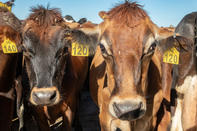
Cows should be milked every 12 hours and in a specific order. Do not milk more than three times a day, as this can cause permanent teat damage. The older cows, those that have been in milk for longer, usually have more bacteria in their udders. Milk the first-calf heifers first, then the cows that are fresh-in-milk, then older cows and lastly mastitis cows. Mastitis milk must be discarded and not mixed with the milk from healthy cows. When you have milked a mastitis udder, wash your hands and dip in a disinfectant.
Cleaning of Cow Udders
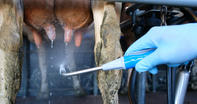
Clean the teats and udder of the cow after fore-milking (fore-milking will help to stimulate the milk letdown but is also high in bacteria). Washing for 20 seconds is 50% more efficient than washing for six seconds. Recent research confirms teats should be dry before milking. Wipe the teats and teat-bases with a disposable paper towel moist with a disinfectant solution.
Wash very dirty udders with clean warm water and a little bit of disinfectant and dry it with a towel. Cotton towels were found to be better than paper towels for reducing bacterial contamination in milk. Never use communal cloths to clean more than one udder. Teat dip can be used before and after milking to ensure the best udder hygiene possible.
Teat Dipping
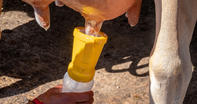
Teat dipping is important to prevent and control mastitis. It can reduce new infections by 70% to 80%. The dip must contain glycerine, lanolin or any other skin conditioners. Dip before milking, but prevent teat dip residue from entering the milk. Pre-clean teats, dip for 30 seconds and test for mastitis and dry teats with a single disposable paper towel per cow.
To prevent contamination of milk, ensure that teats are dry after the pre-milking dip. There is a big difference between pre-milking dip and post-milking dip. Use dip only for its intended purpose. Dip teats immediately after milking to remove milk that is left on the teats. Use a special teat dip cup or a teat spraying system to prevent pathogens from entering the teat canal. The teat dip cup must be washed out after each milking and any leftover dip in the cup must be thrown away.
Cleaning Milking Equipment
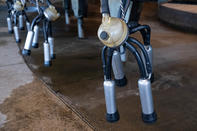
By Marinda Louw